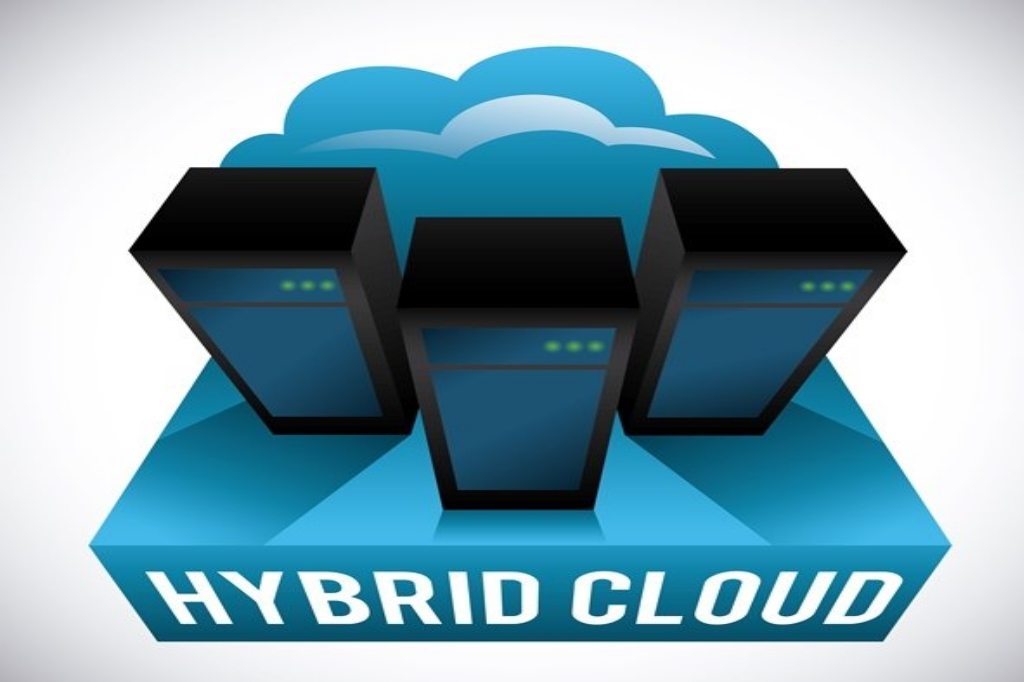In this blog we’ll be taking a look at the pros and cons of hybrid cloud computing. First, let’s make sure we’re clear on what a hybrid cloud actually is:
Defining the Pieces of the Hybrid Cloud
By definition, a hybrid cloud is made up of two or more other kinds of cloud deployments. So we’ll begin by defining public and private clouds.

Public Cloud
The public cloud is probably the most well-known and easily defined of the group at this point.
This is your Amazon Web Services, Microsoft Azure, IBM cloud, and your Google Cloud. These are a few of the big players.
The public cloud is where you access computer resources over the internet along with other users from other companies.
You’re renting space on servers with other tenants. This is sort of like using the public computer at the library.
Just as you may be disturbed or have someone look over your shoulder in the public library, you also may have to worry about other tenants “peeking” into your public cloud implementation.
That being said, this is usually the fault of the enterprise. It is not the cloud company’s security. More on that later.
The public cloud is also the most scalable of cloud implementations. This is because you can use as much of the resources as you need in real-time, although pricing models vary.
You also don’t need to manage any of your own hardware resources in-house if you solely use the public cloud for your workloads.
There are also various models of public cloud services.
The three standard models/acronyms are Software as a Service (SaaS), Platform as a Service (PaaS), and Infrastructure as a Service (IaaS).
Software as a service is basically just an application like Microsoft office that is hosted by the cloud company. It is then utilized by your organization’s users.
Platform as a Service is simply a platform for app development, testing, and implementation. It too is hosted by the cloud company and accessed/used by your organization’s end users.
Infrastructure as a Service is the broadest term. And essentially it provides your organization with all of a data center’s resources remotely to your users for general purpose use, while they manage it and ensure that the data center is running efficiently.
In general though, with a public cloud deployment, you are virtually provisioning things. Because of this, you have very minimal control over how your network is set up.
Many would cite the multi-tenancy of the public cloud as a security issue. But for the most part, if your virtual environment is configured properly and you’ve encrypted your data in the cloud, this isn’t an issue.
Anyways, a hybrid cloud involves mixing and matching any of the typical public cloud offerings along with private cloud deployments. Hybrid cloud often uses several vendors to avoid vendor lock-in.

Private Cloud
The private cloud has been defined in many different ways.
A loose definition might be any cloud deployment used by one organization as a single tenant that has control of the underlying hardware.
By this definition, a private cloud can still take many forms.
A private cloud could be managed, owned, and run by a third party with varying degrees of responsibility. From the organization itself aside from simply using the cloud.
The private cloud could be housed on-premises of the organization, or not.
There will also typically be several business units within the organization that use the cloud hardware in a dynamic fashion.
As one example of a private cloud, a colocated data center implementation involves using the facilities of a colocation vendor.
You are provided with the data center space, cooling/climate control, power, and bandwidth, but not the actual hardware running workloads.
A typical progression might be from on-premises server room to colocated hardware, to managed services private cloud.
Private cloud still does share many of the same features of the public cloud, albeit not always in the same format.
For example, end users in your organization should still be able to utilize the cloud resources as needed just as they might use the public cloud.
They should also be able to access private cloud resources from their whole range of devices, just as Microsoft office could be used via cell phone, laptop, or workstation.
While not as dynamic as a public cloud, a private cloud should still be fairly dynamic.
Resources should be allocated between units of the organization dynamically. These resources should be scaled up and down depending on changing workload densities.
Going hand-in-hand with resource allocation, there should be stringent tracking of resource usage by users to that end.
While there is a lot of variation here, the fundamental features of a private cloud are single-tenancy and in-house control of the hardware layer.

Hybrid Cloud
You could think of the hybrid cloud as simply a mix of private and public cloud implementations.
That’s fairly vague though. So let’s be more specific.
What a hybrid cloud looks like in physical terms is typically an organization’s in-house hardware linked to one or more public cloud sites via Wide Area Network (WAN).
The hybrid cloud is about aggregating and integrating the capabilities and services of cloud providers with on-premises or managed infrastructure resources.
Essentially you’re trying to get the best of both worlds.
For this reason, the hybrid cloud has seen significant growth.
With a five-year compound annual growth rate (CAGR) of 22.3%, public cloud spending will grow from $229 billion in 2019 to nearly $500 billion in 2023.
IDC also raised its forecast for total spending (vendor revenue plus channel mark-up) on cloud IT infrastructure in 2018 to $65.2 billion with year-over-year growth of 37.2%.
The RightScale 2019 State of the Report from Flexera reveals that 84 percent of enterprises have a hybrid multi-cloud strategy.
While the hybrid cloud has been widely adopted, there is significant variation in the methods used to integrate public clouds and private clouds.
One classic example is that of housing mission-critical workloads and sensitive data in-house while using the public cloud’s scalability to run variable workloads and save on operational expenses in slow periods.
There are many orchestration frameworks and integration methods available, though they are generally beyond the scope of this article.
While hybrid clouds can take many forms, there are pros and cons of the hybrid cloud that generally hold true.
A Look at the Pros and Cons of Hybrid Cloud Computing
Hybrid Cloud Benefits
Greater Flexibility
One of the benefits of the hybrid cloud in some cases over using a more static private cloud is effortless agility.
As workloads change, as in busy months or around holidays, the public cloud aspect allows your organization to scale up or down as needed.
This can be conceptualized as a military unit. You have your core unit, and then you have your reserves who can be rapidly deployed to fill in as needed.
As opposed to “training up” new reserves by procuring new servers, they’re already on standby.
Disaster Recovery
One of the most common uses for the hybrid cloud is for dedicated disaster recovery backups.
For example, you may have everything running on your own private cloud. In the event of downtime or some natural disaster, your entire environment is ready to be spun up into the public cloud and activated.
A variation of this concept is in the usage of the public cloud for business continuity.
Essentially you have the public cloud always running so that you have redundancy in the infrastructure running your applications.
While there are many other ways that organizations can protect themselves with disaster recovery protocols in any configuration, the hybrid cloud has certainly saved many organizations in the past.
Cost Savings
As appealing as going all-in on the private cloud can be for control and security purposes, it can be pretty cost-prohibitive in several use cases.
With some types of projects, getting the hardware on-premises to handle them just doesn’t make sense in comparison to using the public cloud.
In these cases, the flexibility of the pay-as-you-go opex model of the public cloud is quite appealing in contrast to massive capital expenditures.
Globalization
Historically, employees have primarily accessed enterprise IT resources locally, and so global availability was not a primary consideration for IT decision-makers.
These days, US companies employee millions of multinational employees that depend on IT services to do their remote work.
The hyperscale cloud companies like AWS are expanding across the globe to accommodate the growing IT infrastructure needs of other countries.
This growth has made it incredibly convenient to provide global accessibility to traveling or remote employees beyond what a typical WAN could provide. And also without the significant costs of having to build data centers abroad.
Use Cases for the Hybrid Cloud
Big data Processing
Let’s say you want to run analytics on a massive data set.
Not many organizations have the infrastructure to handle the growing hardware demands for big data analytics workloads.
The costs to build and maintain something like a hadoop node for data analytics can be extremely cost-prohibitive.
In these cases, it is perfectly viable to just utilize the massive scalability of many high-performance cloud offerings to run your virtual modeling, machine learning algorithms, your big data analytics, or any other computationally intensive workload.
This especially makes sense if you don’t intend to be running these kinds of applications in the long-term.
Highly Dynamic Workloads
Variation in resource usage is to be expected.
That being said, some organizations are highly seasonal, with orders of magnitude greater demands at certain parts of the week or the year than others.
To be able to meet peak demands using solely on-premises hardware or static private cloud capabilities, you would have to procure and maintain a significantly larger volume of hardware year-round.
This simply doesn’t make sense from a financial perspective. So this is one of the most common use cases for a hybrid cloud deployment.
On-Site Security Requirements
In some cases, it’s mandatory to keep critical applications, workloads, or data in-house.
These might be authentication or authorization directories, HIPAA related data, or confidential government data.
While these are kept in the private cloud, frontend interfaces and middleware can still be run in the public cloud for the aforementioned reasons.
Hybrid Cloud Drawbacks
Added Complexity
There are certainly challenges in working with the cloud.
It is decidedly more complex to manage a Wide Area Network as opposed to a single site’s network or simply utilizing a public cloud’s network.
Every single point where data is transmitted between different locations is a potentially new point of vulnerability.
The breadth of the network itself means that the networking specialists have more hardware to configure in the first place.
It can be difficult to ensure uniform user authentication and access protocols across multiple sites.
It is no simple task for network managers and system administrators to meticulously monitor the network.
This may cause complications with compliance or with idle instances left running that are unnecessary.
It can also lead to vulnerabilities.
Cloud security requires a different approach than with on-premises hardware.
The tools and strategies used to manage a WAN, for example, are not sufficient to ensure network and data security across clouds.
Data Transfer Bottlenecks
Bottlenecks are only problematic situationally.
Networking bottlenecks are highly dependent upon the underlying infrastructure and the nature of the packets being sent across the network.
With big data, this can easily become a performance bottleneck. However, preliminary evaluations should be able to tell you whether this should be a consideration.
Another consideration of data transfer is the added difficulty of network security across many different layers.
Wrapping Up
As a wrap up on the pros and cons of hybrid cloud computing:
The implementation of the hybrid cloud has grown substantially over the past few years, along with the other cloud computing models.
Regardless of how or why you are considering implementing a hybrid cloud deployment if you are unsure how to go about logistics for the disposition of your current IT assets, reach out below. We would be happy to give you a free consultation on logistics and asset valuations.





